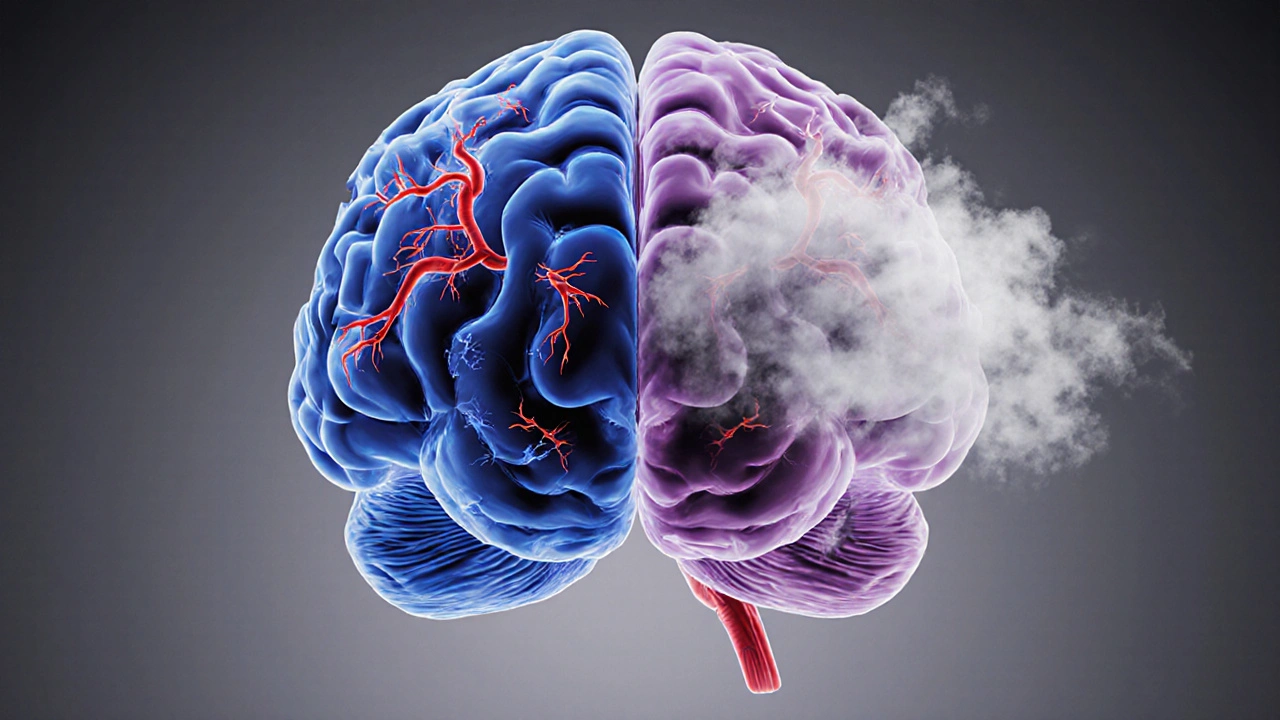Ischemia Risk & Mental Health Assessment
Assessment Guide
Answer the following questions to assess your risk of cerebral ischemia and its potential impact on mental health.
Your Risk Assessment
Risk Level:
When blood supply to the brain drops, the ripple effect goes far beyond physical symptoms. Ischemia can quietly reshape mood, trigger anxiety, and even cloud thinking. Understanding that connection helps you spot warning signs early and take steps before the impact becomes severe.
Key Takeaways
- Reduced blood flow (ischemia) influences neurotransmitter balance, which can spark depression or anxiety.
- Both acute and chronic brain ischemia increase risk for cognitive decline and mood disorders.
- Managing vascular health-through diet, exercise, and medical treatment-directly supports mental well‑being.
- Early detection of mental‑health changes can signal underlying ischemic events.
- Practical lifestyle tweaks and regular monitoring are the most effective prevention tools.
What Is Ischemia?
Ischemia is a condition where blood flow to a tissue is insufficient to meet its metabolic needs, leading to oxygen deprivation. It can affect any organ, but the brain is especially vulnerable because neurons need a constant supply of oxygen and glucose.
Two common forms target the brain:
- Brain Ischemia refers specifically to reduced cerebral blood flow, which may be transient (a brief dip) or prolonged (persistent blockage).
- Stroke is an extreme manifestation where a blood vessel is completely blocked or ruptured, causing sudden, severe loss of function.
Both situations trigger a cascade of cellular events: energy failure, buildup of toxic metabolites, and, crucially for mental health, disruption of neurotransmitter systems.

How Reduced Blood Flow Messes With Your Mood
The brain relies on a steady stream of Blood Flow to deliver oxygen, glucose, and to clear waste products. When flow drops, several mechanisms converge to affect mood:
- Neurotransmitter Imbalance: Ischemia hampers the synthesis of serotonin, dopamine, and norepinephrine-chemicals that regulate happiness, motivation, and stress response.
- Inflammatory Response: Deprived tissue releases cytokines that can cross the blood‑brain barrier, fostering a low‑grade inflammatory state linked to depressive symptoms.
- HPA‑Axis Activation: The body perceives ischemic stress as a threat, prompting cortisol release. Chronic cortisol elevation is a known risk factor for anxiety and mood swings.
- Structural Damage: Repeated episodes can erode white‑matter tracts, especially in the prefrontal cortex and hippocampus-areas crucial for emotional regulation and memory.
Because these changes happen silently, many people attribute mood dips solely to “stress” or “life events” without realizing a vascular component may be at play.
Common Mental‑Health Issues Linked to Cerebral Ischemia
Research from leading neurology centers shows a clear pattern: individuals with a history of brain ischemia are more likely to develop specific mental‑health conditions.
| Condition | Acute Ischemia (e.g., Transient Ischemic Attack) | Chronic Ischemia (e.g., Small Vessel Disease) |
|---|---|---|
| Depression | 15‑20% develop depressive symptoms within 3 months | 30‑45% experience persistent depressive disorder |
| Anxiety | 10‑12% report heightened anxiety post‑event | 25‑35% develop generalized anxiety |
| Cognitive Impairment | Transient memory lapses, often reversible | Progressive decline, up to mild dementia |
| Sleep Disturbances | Night‑time awakenings linked to stress response | Insomnia and fragmented sleep become chronic |
Two mental‑health entities stand out:
- Depression often presents as low energy, loss of interest, and feelings of hopelessness.
- Anxiety may show up as constant worry, racing thoughts, and physical tension.
Both are tied to the same biochemical disturbances caused by inadequate cerebral perfusion.
Managing the Vascular‑Mental Health Link
Because the root cause is blood flow, the most effective interventions target the cardiovascular system. Below are evidence‑based strategies that simultaneously protect the brain and lift mood.
1. Optimize Blood Pressure
Hypertension is the biggest modifiable risk factor. Aim for a systolic < 130mmHg and diastolic < 80mmHg. If lifestyle changes aren’t enough, discuss ACE inhibitors or ARBs with your physician-these drugs have been shown to reduce both stroke risk and depressive symptoms.
2. Adopt a Brain‑Friendly Diet
The Mediterranean diet tops the list: plenty of leafy greens, oily fish, nuts, olive oil, and limited red meat. Studies report a 25% lower incidence of cognitive decline and a 15% drop in depression scores among adherents.
3. Regular Physical Activity
At least 150minutes of moderate aerobic exercise per week improves endothelial function and boosts serotonin production. Even a brisk 30‑minute walk three times a week can raise mood‑related neurotrophic factors by 30%.
4. Sleep Hygiene
Consistent 7‑9hour sleep cycles support glymphatic clearance-a brain‑washing system that removes waste after ischemic episodes. Use dark curtains, limit screens, and keep a regular bedtime.
5. Stress Management
Mind‑body practices such as mindfulness meditation reduce cortisol and improve heart‑rate variability. A meta‑analysis of 18 trials found a 22% reduction in anxiety scores after eight weeks of guided meditation.
6. Medical Monitoring & Medication
For those with known vascular disease, antiplatelet agents (e.g., aspirin) and statins lower the chance of new ischemic events. Some statins also have modest antidepressant effects, likely through anti‑inflammatory pathways.

Practical Daily Checklist
- Check blood pressure every morning; keep a log.
- Include at least two servings of fatty fish or walnuts weekly.
- Take a 30‑minute walk after dinner, three times a week.
- Set a consistent bedtime; avoid caffeine after 2pm.
- Practice 10 minutes of deep‑breathing or guided meditation daily.
- Schedule annual check‑ups with a neurologist or cardiologist if you have risk factors.
When to Seek Professional Help
If you notice any of these red flags, it’s time to call a healthcare provider:
- Sudden, persistent mood changes lasting more than two weeks.
- New episodes of confusion, memory loss, or difficulty finding words.
- Unexplained headaches combined with anxiety or depression.
- Any neurologic symptoms-numbness, weakness, vision changes.
Early intervention can prevent a reversible mood disturbance from becoming a chronic condition.
Frequently Asked Questions
Can a single mini‑stroke trigger depression?
Yes. A transient ischemic attack (TIA) can cause a sudden drop in serotonin levels, leading to depressive symptoms that may appear within days. Prompt medical treatment and early counseling often mitigate long‑term effects.
Is anxiety always a sign of brain ischemia?
No. Anxiety has many triggers, but if you have vascular risk factors (high blood pressure, diabetes, smoking) and notice a new, persistent worry pattern, it’s worth checking cerebral blood flow with a doctor.
Do statins really help with mood?
Research suggests statins lower inflammation, which can alleviate depressive symptoms in some patients. They are not a replacement for antidepressants but can be part of a comprehensive vascular‑mental health plan.
How long does it take for lifestyle changes to improve mental health?
Most people notice mood improvements within 4‑8 weeks of consistent exercise, better sleep, and a healthier diet. Brain perfusion metrics often show measurable changes after 12 weeks of regular cardio activity.
Should I get brain imaging if I feel down?
Only if you have additional risk factors or neurologic signs. MRI or CT scans can detect silent ischemic lesions, but they’re not routine for isolated mood symptoms without other concerns.

Amy Elder
October 8, 2025 AT 14:31Take it easy, every step counts.
Erin Devlin
October 20, 2025 AT 12:31Thinking about brain blood flow reminds us how fragile our mental balance truly is. A few lifestyle tweaks can shift that balance dramatically. It’s worth reflecting on which habits you can improve today. Small changes often lead to big mental benefits.
Will Esguerra
November 1, 2025 AT 09:31One must not underestimate the dire ramifications of sustained cerebral hypoperfusion; it is not merely a physiological inconvenience but a profound insult to the very architecture of affective regulation. When ischemic episodes recur, neurotransmitter synthesis falters, cortisol spikes, and the individual is thrust into a vortex of melancholy and dread. The clinical literature unabashedly chronicles the correlation: elevated risk of major depressive disorder, heightened anxiety indices, and an inexorable march toward cognitive deterioration. Moreover, the inflammatory cascade unleashed by oxygen debt further corrodes neuronal integrity, particularly within the prefrontal cortex and hippocampal formations. It is incumbent upon both clinician and patient to recognize these signals early, lest the insidious decline become irreversible.
Allison Marruffo
November 13, 2025 AT 07:31Your summary captures the core mechanisms nicely. Incorporating regular aerobic exercise and a Mediterranean diet can indeed restore endothelial function and boost serotonin production. Consistency is key-tracking blood pressure and sleep patterns helps identify subtle shifts before they manifest as mood disturbances.
Ian Frith
November 25, 2025 AT 05:31Let's break this down step by step, because understanding the interplay between vascular health and mental well‑being can feel overwhelming at first, but it doesn't have to be. First, consider blood pressure: maintaining a systolic reading below 130 mmHg reduces shear stress on arterial walls, which in turn eases the burden on the delicate capillaries supplying the brain. Second, diet plays a pivotal role; omega‑3 fatty acids found in oily fish, along with polyphenols in berries, act as neuroprotective agents, mitigating inflammatory cytokine release that otherwise would dampen mood. Third, physical activity does more than burn calories-it stimulates the production of brain‑derived neurotrophic factor (BDNF), a protein that supports neuron growth and resilience, directly counteracting the depressive effects of chronic ischemia. Fourth, sleep hygiene is often overlooked, yet during deep sleep the glymphatic system flushes metabolic waste from the brain; disrupted sleep leaves these toxins to accumulate, aggravating both cognitive fog and irritability. Fifth, stress management techniques such as mindfulness meditation or progressive muscle relaxation lower cortisol levels, which, when chronically elevated, can impair synaptic plasticity and exacerbate anxiety. Sixth, pharmacological interventions-ACE inhibitors, ARBs, and certain statins-have been shown to not only lower cardiovascular risk but also exert modest antidepressant effects, likely through anti‑inflammatory pathways. Seventh, regular monitoring through primary‑care visits, annual lipid panels, and, if indicated, neuroimaging can catch silent micro‑infarcts before they manifest clinically. Eighth, community support and counseling provide an emotional buffer, reinforcing coping strategies and encouraging adherence to lifestyle changes. Ninth, avoid smoking and limit alcohol; both substances constrict cerebral vessels and disrupt neurotransmitter balance. Tenth, stay hydrated, because dehydration can thicken blood, reducing cerebral perfusion even in the absence of overt disease. Eleventh, manage comorbid conditions such as diabetes, as hyperglycemia further impairs endothelial function. Twelfth, maintain a consistent routine-predictability reduces the cognitive load on an already taxed brain. Thirteenth, consider regular cognitive exercises, like puzzles or learning a new skill, to keep neural pathways active. Finally, remember that progress is incremental; many patients report noticeable mood improvements within four to eight weeks of sustained effort, while measurable changes in cerebral blood flow often appear after three months of consistent cardio. By integrating these strategies, you create a robust, multi‑layered defense against the silent threat of ischemia‑induced mood disorders.
Beauty & Nail Care dublin2
December 7, 2025 AT 03:31Wow, this is like a secret government plot 🕵️♀️. They dont tell u that the boring diet is actually a mind control tool, hehe. My grandma swears by herbal tea 🍵 and the stars align when you skip the meds. Also, the wifi at night can mess with your brain flow, trust me! lol
Oliver Harvey
December 19, 2025 AT 01:31Interesting points, but let me correct a few things: "stress" should be "stress," and "effects" needs an apostrophe when showing possession – "effect's." Also, "brain" is singular, not "brains" in this context. Just a friendly reminder to keep an eye on grammar.